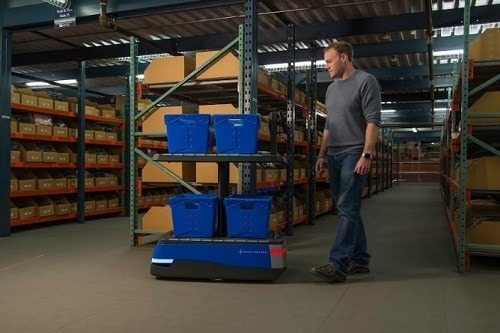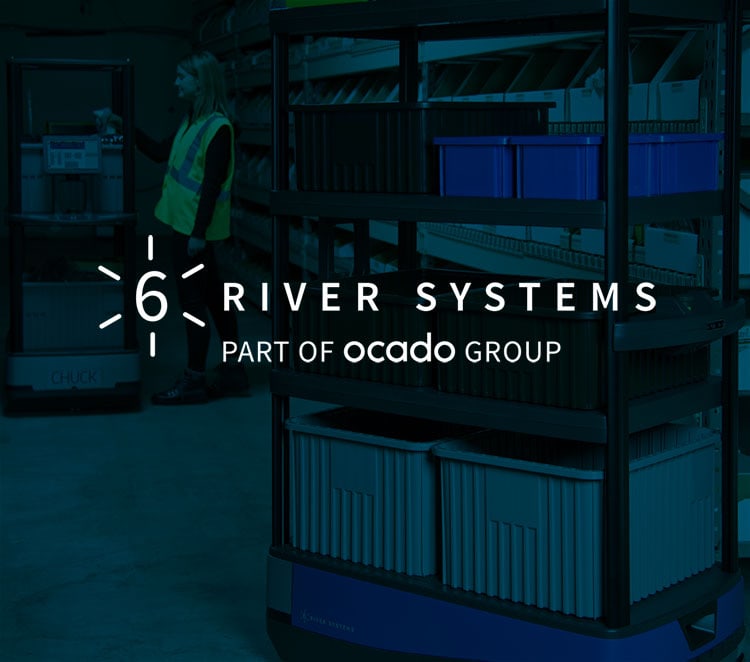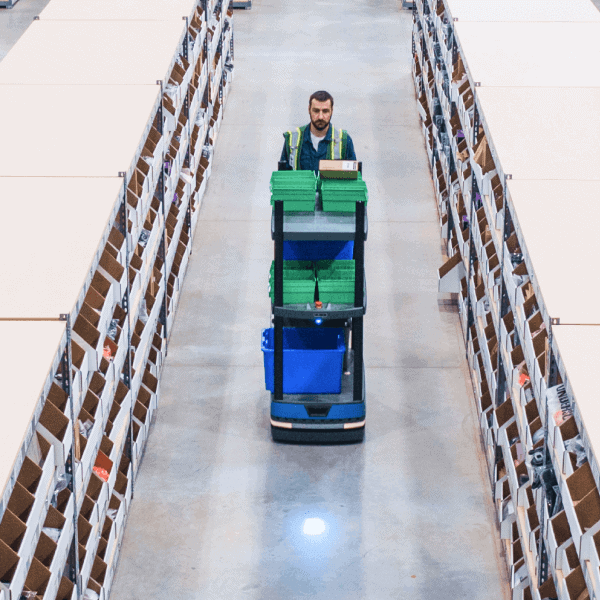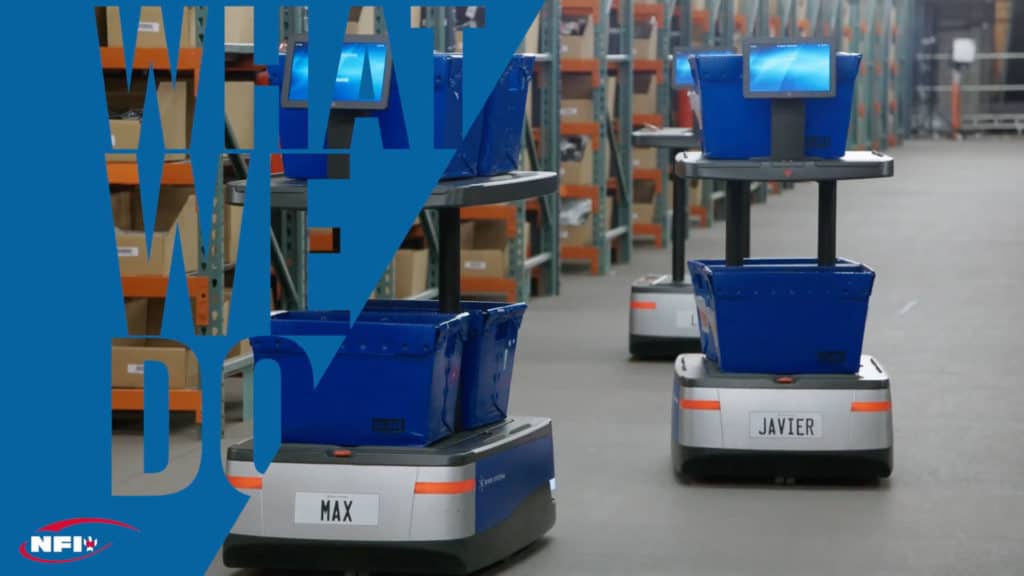The adoption of robots in warehousing, once considered a pipe dream, has become mainstream. According to market intelligence firm Tractica, nearly a million warehousing and logistic robots will be shipped annually by the year 2022 — almost five times the volume in 2018. It is not a surprise as the efficiency and cost advantages of using robots in the warehouse have increased in recent years. With growing interest in robotics, there are now several types of mobile robots leveraged by the warehousing industry.
The autonomous mobile robots (AMR) used in warehouses can be classified on the guidance systems they use, the functionality accomplished by the robot, and a combination of two. The classification based on functionality gives a better understanding of how mobile robots fit into the regular workflow of warehouses. Here’s a look at five types of mobile robots that are changing the face of warehousing.
1. Goods-to-person AMRs
There are two ways to implement goods-to-person AMRs:
- The robot carries an entire shelf to the person picking goods. The picker can pick the product from the shelf and the robot will return the shelf to its original position.
- The AMRs queue before the stations where associates are located, the associate picks the product from the first AMR, sends it back and the next AMR in the queue comes forward.
The idea for goods-to-person AMRs is to reduce walking that warehouse associates have to undergo to pick items from a large warehouse. This model boosts efficiency by completely removing walking between pick locations and employee workstations.
2. Collaborative mobile robots

In this model, a warehouse associate follows a collaborative mobile robot as the robot guides the associate through each task. Chuck by 6 River Systems, for example, leverages artificial intelligence and machine learning to group similar tasks together and prioritize work based on the current conditions on the warehouse floor, leading associates through their work zones to minimize unnecessary walking. Chuck displays an image of the item, location and quantity to pick. The associate picks the items, scans them to confirm accuracy and places them in the correct bin, aided by put-to-light technology. Once containers are loaded, Chuck transports the bins to the next zone or work area autonomously.
Built with the same technology and sensors as autonomous vehicles, Chuck doesn’t require fixed guidance like rails or magnetic strips to navigate the warehouse, making it easy to integrate with your existing infrastructure. By eliminating the need for associates to push and pull heavy manual order picking carts and eliminating the long walk, collaborative mobile robots reduce the physical strain on your associates, allowing them to remain active and alert to work more efficiently and accurately. Warehouses that implement collaborative mobile robots can see up to 2-3x increases in productivity.
3. Autonomous forklifts
Autonomous forklifts are being developed by startups and traditional forklift manufacturers to automate full pallet operations. The fully autonomous truck relies on vision-based guidance systems to carry out its operations. Autonomous lift trucks intend to take over the most labor-intensive operation in a distribution center.
There are several types of autonomous forklifts, including:
- Pallet movers (or automated pallet jacks): This type of autonomous forklift is modeled after the traditional pallet jack and offers limited vertical load movement for reaching pallets on low-height racks and shelves or floor-to-floor operations. Autonomous pallet movers are the smallest type of autonomous forklift.
- Counterbalanced automated guided forklifts: This type of autonomous forklift counterbalances the load weight with weight located in the truck’s rear. Counterbalanced automated guided forklifts are ideal for moving pallets to and from storage and are commonly used in shipping and receiving operations.
- Straddle forklift AGVs (or outrigger AGVs): These autonomous forklifts have two horizontal legs to stabilize the truck. They require less space to maneuver compared to counterbalanced automated guided forklifts.
- Very narrow aisle width AGVs (VNAs): VNAs are efficient automated robotics solutions for transporting heavy loads throughout large warehouses and warehouses that utilize high vertical storage space. As their name suggests, they’re capable of operating in narrow aisles, so they can accommodate warehouses designed with narrow aisle widths to maximize storage capacity.
4. Enhanced sortation solutions

Sorting is one of the most tedious processes in a warehouse, requiring human workers to identify individual items and direct them to the appropriate locations within the warehouse. It’s an inefficient and repetitive task that’s prone to human error, resulting in increased labor costs for non-value-added tasks. Items diverted to the wrong location, for example, require additional time to track down those items and transport them to the correct locations. Collaborative sorting solutions, such as Mobile Sort by 6 River Systems, speed up the sortation process and improve accuracy with an intuitive interface that uses lights, sensors and images to direct associates to the correct bins and alert associates when items are placed in incorrect bins.
Other AMRs for sorting include types of mobile robots that rely on articulated robotic arms, computer-aided vision, and algorithms to distinguish various objects. If a new object needs to be added to the sorting mix the AMR needs to be trained for identifying and handling it. The current implementation of sorting AMRs are with objects that can be identified with some sort of scanner. Still others use machine learning, AI and visual sensors to identify objects. Conveyor rollers, tilt trays, and cross-belt systems are used for automated sorting. AMRs are implemented for high-speed parcel sortation, e-commerce order fulfillment and returns handling.
5. Automated storage and retrieval systems (AS/RS)
AS/RS is used to retrieve and or store products in designated locations without human intervention. These types of mobile robots are complex systems that can be implemented in multiple ways with robotic arms, cross-belts, conveyor belts, carousels, vertical lifts, robotic cranes, etc. The exact method of implementation will depend on weight, size of the product to be handled, frequency of storage or retrieval, time in storage, and other custom warehouse requirements.
The efficiency AMRs bring to the warehouse is unparalleled and will be ubiquitous in warehouse operation soon. To learn more about how to leverage collaborative mobile robots to increase labor productivity and operational flexibility, download our white paper, The Business Case for Collaborative Mobile Robotics.


